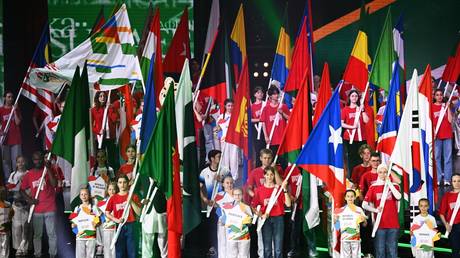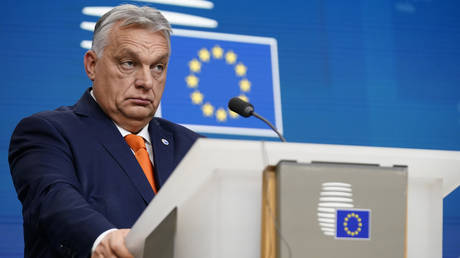Waves of Israeli airstrikes have targeted Hezbollah’s missile arsenal, placing the group and its Iranian backers in a bind.
RABIH DAHER/AFP via Getty Images
Israel is trying to destroy the long-range missiles that Hezbollah views as their foremost weapon.These missiles are most threatening when fired together in a large salvo.”It can only really be done once,” a Middle East expert told BI.
The Israeli Air Force is pounding the enormous missile arsenal Hezbollah built up over the past 18 years since its last full-fledged war with Israel. The aerial bombardment is so relentless — 2,000 targets struck in the first three days — that Hezbollah could quickly find itself in a “use it or lose it” dilemma over the long-range missiles the group and Iran view as its most formidable weapon.
“The Israeli military campaign is expected to persist over the coming weeks, beginning with an extensive phase of aerial bombardments targeting Lebanon,” Freddy Khoueiry, a global security analyst for the Middle East and North Africa at the risk intelligence company RANE, told Business Insider.
“Should these efforts fail to achieve the desired strategic outcomes — which is likely, the risk of a subsequent phase involving ground operations increases,” Khoueiry said.
Israel launched Operation Northern Arrows on Monday, attacking 1,500 Hezbollah targets in 200 areas in Lebanon, destroying several rocket launchers, weapons depots, and drones, using 250 fighter jets. The targets are mainly in South Lebanon and the Beqaa Valley where Hezbollah has a strong presence. Lebanese media reported Wednesday that Israel also attacked villages north of the Lebanese capital Beirut.
“Israel appears to have been able to devastate Hezbollah’s missile arsenal and launch capacity in Lebanon with airstrikes, and certainly has decimated the IRGC [Iran’s Islamic Revolutionary Guard Corps paramilitary] network’s command-and-control structure in Lebanon,” Kyle Orton, an independent Middle East analyst, told BI.
The air war is attempting to destroy Hezbollah’s long-range missile arsenal, their most threatening weapons for Israelis which Iran provided as a last-resort threat to safeguard its nuclear program.
“Both an aerial bombing campaign and ground incursions, while impactful, are unlikely to completely dismantle Hezbollah’s military infrastructure or eliminate its long-term operational capacity,” RANE’s Khoueiry added.
“Hezbollah is a much more organized and entrenched group than Hamas, and Lebanon’s wider geographic landscape provides the group with opportunities to adjust and adapt.”
Hezbollah fired a ballistic missile at Tel Aviv in central Israel on Wednesday morning, the first time it has done so since it began skirmishing with Israel nearly a year ago. Israeli air defenses successfully intercepted it. If a similar attack causes casualties or destruction, Israel may extend its campaign against Hezbollah’s urban stronghold in southern Beirut.
Israel’s army chief visited troops in Israel’s north on Wednesday, the third day of this campaign, and hinted at a possible ground operation. Hundreds of thousands of people have been forced from their homes by the artillery battles across the border. Israel aims to compel Hezbollah to withdraw all its forces and weapons from the Lebanese border regions with Israel and north of South Lebanon’s Litani River, so the tens of thousands of Israelis displaced by the border clashes since October can return.
A portrait of Hezbollah chief Hassan Nasrallah rests amid destruction in a southern Lebanon area hit by Israel airstrikes.
MAHMOUD ZAYYAT/AFP via Getty Images
Hezbollah’s long-range weapons can reach well beyond the northern Israel border regions it has blasted with drone and rocket fire. Orton noted that Hezbollah has demonstrated a “marked disinclination” against firing long-range missiles to date, speculating that it has now only done so after facing several setbacks, including the injury of thousands of its fighters by explosive-rigged pagers.
“The probable reason for this is a combination of Israel degrading the launchers so severely and the political consideration that the mass-launch of long-range missiles is supposed to be the deterrent that prevents an Israeli strike at Iran directly,” Orton said.
“It can only really be done once, and there is a wariness about exposing this threat as hollow.”
Numbering up to 150,000 surface-to-surface munitions, Hezbollah has more surface-to-surface missiles and rockets in its arsenal than any other militant group. It is much larger than what the group had the last time it fought a full-fledged war with Israel in 2006. In addition to short-range munitions, Hezbollah also has short-range ballistic missiles and precision-guided munitions.
“Hezbollah is undoubtedly under significant pressure to deploy its more advanced capabilities and achieve successful strikes, particularly as recent tactical losses have further diminished its deterrent effect and weakened its internal image,” Khoueiry said.
“A single missile could miss its intended target, causing mass casualties and triggering a proportional Israeli retaliation.”
Iran, which has the largest ballistic missile arsenal in the Middle East, armed Hezbollah, its most powerful and important proxy, with variants of its indigenous drones and missiles over the past two decades.
With Iran’s help, Hezbollah acquired large numbers of Zelzal-1 and Zelzal-2 long-range artillery rockets and Fateh-110 short-range ballistic missiles, specifically the Syria-produced M-600 variant. It also has tens of thousands of long-range unguided rockets, including the Fajr-3 intermediate-range multiple launch artillery rocket and the Fajr-5 multiple launch rocket system.
Iran views these missiles as a means of counterattack if the Israelis follow through on threats to bomb Iran’s nuclear program. That is one reason it proved reluctant to risk an all-out war between Hezbollah and Israel.
“The Israel campaign can significantly degrade Hezbollah’s capabilities, but they would be re-buildable,” Arash Azizi, a senior lecturer in history and political science at Clemson University and author of “The Shadow Commander: Soleimani, the US, and Iran’s Global Ambitions,” told BI. “It will set Hezbollah back but won’t permanently put it out.”
While condemning Israel’s attacks, Iran has not militarily intervened on Hezbollah’s behalf. It last took action in April, with missile attacks directly against Israel after an Israeli airstrike killed IRGC commanders in Syria. It vowed retaliation for Israel’s killing of Hamas chief Ismail Haniyeh in Tehran in July but has not done so by late September. Hezbollah is a far more important proxy and asset for Iran than Hamas or any other regional group.
Azizi noted that Iran still doesn’t want a war since it doesn’t have “a lot of great military options” against Israel.
“Iran also currently prioritizes economic development, which requires peace in the region and beyond,” Azizi said. “But there is a limit to such logic, i.e., in some points, if the escalation continues, Iran might have no choice but to attack Israel and get involved more broadly.”
Many Iranians support the new Iranian president’s peace overtures at the United Nations. Still, it’s possible that the destruction of its Hezbollah missile deterrent will convince Iranian officials to build nuclear weapons faster as the ultimate deterrent.
“Many in Iran and the Iranian establishment now believe that Iran has no choice but to pursue nuclear weapons,” Azizi said. “The dominant opinion still probably prefers Iran to use its nuclear advances to make some sort of a deal with the West as opposed to pursue a nuclear weapon.”
“But the more Iran feels isolated, weak, and defeated, the more there is a chance that it will go toward the nuclear test option.”





+ There are no comments
Add yours